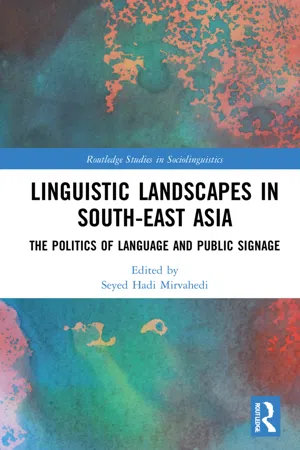Introduction
It has now become something of a commonplace that globalization does not just mean homogeneity and sameness but also heterogeneity and difference. The economic, cultural and ideological flows in globalization are characterized by processes referred to in the concepts of glocalization (Robertson, 1995), hybridization and “global mélange” (Nederveen Pieterse, 2004), and re-embedding (Giddens, 1990) (see also Appadurai, 1996, 2001). In Applied Linguistics, the erstwhile viewpoint of English’s global spread as a form of cultural imperialism fails to reflect sufficiently transcultural flows of English and the reality as to how it has been localized in different contexts of use (cf. Park & Wee, 2012; Pennycook, 2007; Young, 2017).
This chapter sets out to look into the bidirectional process of globalization, that is, universalization and particularization, and how it is represented in language use on signage in the public spaces of Hanoi, one of the oldest capital cities in South-East Asia (SEA). The study of linguistic landscape (henceforth LL) in SEA has so far presented no shortage of case studies on the ascendency of English in urban spaces of the region, which elucidates eloquently the homogenization process of globalization (see Huebner, 2006; Kasanga, 2012; Manan et al., 2015; Taylor-Leech, 2012). This chapter, however, provides a discussion on how globalization and the spread of English in the region may give rise to a consciousness of reinforcing heterogeneity in language, culture and identity. It therefore serves as a testament to what LL can contribute to the understanding of globalization especially with respect to translocal flows of ideas, ideology and culture.
Language ideology and LL research
Language ideology is a concept of controversy because its meaning, scope and application are not easy to delimit. If one puts it simply that language ideology refers to ideas about language, there is a paradox that ideas about language are never simply about language (Rosa & Burdick, 2017). It is even argued that ideas about language are not about language at all, because language use is tied to and governed by a variety of factors such as identity, power, morality, aesthetics and epistemology (Woolard, 1998). For this reason, language ideology has had a long tradition being regarded as a peripheral topic before it was rescued from scholarly neglect and developed into a field of enquiry (Kroskrity, 2006).
The study of language ideology initially centres on the speakers’ awareness of language structure and change, which is indicated in Silverstein’s (1979) definition that reads, “a set of beliefs about language articulated by users as a rationalization or justification of perceived language structure and use” (p. 193). Subsequent approaches to language ideology tend to put a greater emphasis on social, political and cultural aspects of this concept. Heath (1989), for instance, sees it as “self-evident ideas and objectives a group holds concerning roles of language in the social experiences of members as they contribute to the expression of the group” (p. 393). Regardless of the different emphases in these approaches, there is mutual consensus that language ideology functions as “a mediating link between social structures and forms of talk” (Woolard & Schieffelin, 1994, p. 55). It (re)constructs linguistic forms and the social/cultural identity of language users (Wortham, 2008).
LL has shown a potential in addressing insightful ideology-related issues including but not limited to social contestation, power manoeuvring and identity construction. The literature on social contestation is exuberant and concentrates on how written language, be it on signage or other linguistic artifacts, in the public spaces of multilingual cities, especially those characterized by sociopolitical disputes, does not reflect actual language diversity but is employed as a vehicle for social and ideological conflicts (Pütz & Mundt, 2018; Rojo, 2016; Rubdy & Ben-Said, 2015). Another remarkable segment of research is dedicated to the ideology of nation-building and/or nationalism, how it is realized through the institutionalization of the nation-state’s language policies and what impacts it has on language use on signage in public spaces (David & Manan, 2015; Lanza & Woldemariam, 2009; Trumper-Hecht, 2009). This research orientation demonstrates how language ideology is wielded as a tool to rationalize existing social structures in the struggle to acquire and maintain asymmetrical power relations. And lastly, the field also investigates discrepancies in language ideology of the state and the people and how it is mediated in language use on public and private signage. Studies in this direction elaborate on the burgeoning of English in public spaces worldwide and how such a reality reflects the ideologies of postmodernism and neoliberalism in language practice on the one hand, and indicates the ordinary people’s desire to construct modern and cosmopolitan identity on the other (Kasanga, 2010; Lipovsky, 2019, see also Blackwood et al., 2016; Manan et al., 2015).
However, the literature of the field has so far shown a rather exclusive concentration on the state-endorsed ideology and tends to see language practice at grassroots levels as a circumvention or resistance to rigid language policies of the authoritative government instead of shedding light into the people’s kaleidoscopic ideology. The propensity to approach language ideology as a universally fixed concept associated with state-making politics and political power manoeuvring cannot address comprehensively its plurality, partiality and contestability, especially in the dynamics of globalization. Studying the ideology governing language practice at grassroots levels is intended to overcome this shortcoming, because language ideology does not come merely from the ruling class. It is also an “ubiquitous set of diverse beliefs … used by speakers of all types as models for constructing li...
